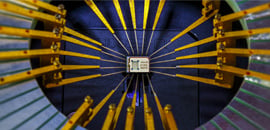Introduction
The Mercury™ 3000Si, 3500Si, and Mercury II™ 5800Si and 6800Si are MicroE’s smart programmable encoder systems with high speed serial word output. Unlike analog or A-quad-B encoders which must transmit data constantly to the motion controller in order to maintain accurate position information, the serial word interpolator is always keeping track for you. This means that the controller need only communicate with the encoder when it actually requires a position.
SPI Format
Serial Peripheral Interface (SPI) format was developed by Motorola. It is a common and widely recognized format that is supported by many microprocessor peripheral chips. As its name implies, it is an interface format not a protocol which means that it simply defines hardware connections not making any demands on actual binary word format. SPI is a master/slave arrangement. In our example, the controller is the master and the encoder the slave. At its core, SPI stipulates 4 wires for basic communication: clock (SCLK), master-out/slave-in (MOSI), master-in/slave-out (MISO), and chip-select (CS). The master drives the clock and provides the chip-select signal to activate the peripheral’s ICs. Since in our case, the encoder does not receive any data from the controller, the MOSI line is eliminated.
M3000Si
The principal limiting factor in A-quad-B encoder speed is how quickly the A and B pulses can be transmitted. When sensor speed is high and/or the interpolation depth is high, the quadrature output frequency soon gets beyond the range of most quad-counters and motion controllers. Since these quad pulses never need to leave the interpolator we’re free to operate at the sensor head’s full bandwidth all the time. The overwhelming majority of motor controllers are not equipped, off the shelf, accepting SPI format encoder outputs. As a result, the customer will typically need a custom design in order to communicate with the encoder system but the speed/resolution advantage will be significant. The Mercury 3000Si data word is 36 bits long with 19.5nm resolution (10 bits) and in SPI format. SPI is discussed later in this report. It supports a maximum clock speed of 10MHz. Factoring in the inherent timing delays, the system can output a new 36 bit word every 4000ns. This works out to a word rate of 250kHz. The word is broken down into three distinct sections: 8 bits of status information, an 18 bit fringe counter and 10 bits of interpolation.














